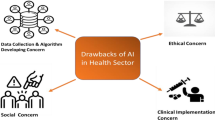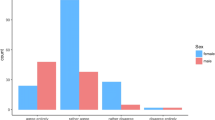Abstract
Health examinations play a key role in preventive medicine. We propose a health examination system named Health Examination Automatic Logic System (HEALS) to assist clinical workers in improving the total quality of health examinations. Quality of automated inference is confirmed by the zero inference error where during 6 months and 14,773 cases. Automated inference time is less than one second per case in contrast to 2 to 5 min for physicians. The most significant result of efficiency evaluation is that 3,494 of 4,356 (80.2%) cases take less than 3 min per case for producing a report summary. In the evaluation of effectiveness, novice physicians got 18% improvement in making decisions with the assistance of our system. We conclude that a health examination system with a clinical decision system can greatly reduce the mundane burden on clinical workers and markedly improve the quality and efficiency of health examination tasks.












Similar content being viewed by others
Reference
Fitzmaurice, J. M., Adams, K., and Eisenberg, J. M., Three decades of research on computer applications in health care medical informatics support at the agency for healthcare research and quality. J. Am. Med. Inform. Assoc. 9:144–160, 2002. doi:10.1197/jamia.M0867.
Fuh, C. S., and Kuo, K. L., The decision support system used in HEALS (Health Examination Automatic Logic System). 2006 American Medical Informatics Association Spring Congress Poster. May 16–18, 2006.
Kuo, K. L., and Fuh, C. S., HEALS: Health Examination Automatic Logic System. 2006 American Medical Informatics Association Spring Congress Poster. May 16–18, 2006.
Canadian Task Force on Preventive Health Care, Evidence-based clinical prevention. 2000.
Canadian Task Force on the Periodic Health Examination: Periodic health examination monograph: report of the Task Force to the Conference of Deputy Ministers of Health. 1980.
Agency for Healthcare Research and Quality, Guide to Clinical Preventive Services, 2006: Recommendations of the U.S. Preventive Services Task Force. AHRQ Publication No. 05-0570. 2006.
Ohno-Machado, L., Gennari, J. H., Murphy, S. N., et al., The GuideLine interchange format: a model for representing guidelines. J. Am. Med. Inform. Assoc. 5:357–372, 1998.
Wang, D., Peleg, M., Tu, S. W., et al., Representation primitives, process models and patient data in computer-interpretable clinical practice guidelines: a literature review of guideline representation models. Int. J. Med. Inform. 68:59–70, 2002. doi:10.1016/S1386-5056(02)00065-5.
Bennett, J. W., and Glasziou, P. P., Computerised reminders and feedback in medication management: a systematic review of randomised controlled trials. Med. J. Aust. 178:217–222, 2003.
Casalino, L., Gillies, R. R., Shortell, S. M., et al., External incentives, information technology, and organized processes to improve health care quality for patients with chronic diseases. JAMA. 289:434–441, 2003. doi:10.1001/jama.289.4.434.
Chaudhry, B., Wang, J., Wu, S., et al., Systematic review: impact of health information technology on quality, efficiency, and costs of medical care. Ann. Intern. Med. 144:742–770, 2006.
Jiang, S. T., How information technologies have improved both productivity and quality of health care. J. Med. Eng. Technol. 29:38–41, 2005. doi:10.1080/03091900412331271130.
Nobel, J., Bridging the knowledge-action gap in diabetes: information technologies, physician incentives and consumer incentives converge. Chronic Illn. 2:59–60, 2006.
Sequist, T. D., Cullen, T., and Ayanian, J. Z., Information technology as a tool to improve the quality of American Indian health care. Am. J. Public Health. 95:2173–2179, 2005. doi:10.2105/AJPH.2004.052985.
Sim, I., Gorman, P., Greenes, R. A., et al., Clinical decision support systems for the practice of evidence-based medicine. J. Am. Med. Inform. Assoc. 8:527–534, 2001.
Evans, R. S., Pestotnik, S. L., Classen, D. C., et al., A computer-assisted management program for antibiotics and other antiinfective agents. N. Engl. J. Med. 338:232–238, 1998. doi:10.1056/NEJM199801223380406.
Hunt, D. L., Haynes, R. B., Hanna, S. E., et al., Effects of computer-based clinical decision support systems on physician performance and patient outcomes a systematic review. JAMA. 280:1339–1346, 1998. doi:10.1001/jama.280.15.1339.
Johnston, M. E., Langton, K. B., Haynes, R. B., et al., Effects of computer-based clinical decision support systems on clinician performance and patient outcome: a critical appraisal of research. Ann. Intern. Med. 120:135–142, 1994.
Osheroff, J. A., Teich, J. M., Middleton, B., et al., A roadmap for national action on clinical decision support. J. Am. Med. Inform. Assoc. 14:141–145, 2007. doi:10.1197/jamia.M2334.
Teich, J. M., Osheroff, J. A., Pifer, E. A., et al., Clinical decision support in electronic prescribing: recommendations and an action plan report of the joint clinical decision support workgroup. J. Am. Med. Inform. Assoc. 12:365–376, 2005. doi:10.1197/jamia.M1822.
Rector, A. L., Thesauri and formal classifications: terminologies for people and machines. Methods Inf. Med. 37:501–509, 1998.
Rosenbloom, S. T., Miller, R. A., Johnson, K. B., et al., Interface terminologies: facilitating direct entry of clinical data into electronic health record systems. J. Am. Med. Inform. Assoc. 13L:277–288, 2006. doi:10.1197/jamia.M1957.
Russell, S. J., and Norvig, P., Artificial intelligence: a modern approach, 2nd edition. Prentice Hall, Englewood Cliffs, NJ, New Jersey, 2003.
Kantor, G. S., Wilson, W. D., and Midgley, A., Open-source software and the primary care EMR. J. Am. Med. Informat. Assoc. 10:616, 2003.
The, P.H.P.: Group, PHP: Hypertext Preprocessor. [cited on Dec. 27, 2008]. Available from: http://www.php.net/.
Sun Microsystems, Inc.: About the Java Technology. [cited on Dec. 27, 2008]. Available from: http://java.sun.com/docs/books/tutorial/getStarted/intro/definition.html.
W3C, Extensible Markup Language (XML). [cited on Dec. 27, 2008]. Available from: http://www.w3.org/XML/.
The Apache Software Foundation, The Apache HTTP Server Project.: [cited on Dec. 27, 2008]. Available from: http://httpd.apache.org/.
The Apache Software Foundation: Apache Tomcat. [cited on Dec. 27, 2008]. Available from: http://tomcat.apache.org/.
Linux Online, Inc.: What is Linux. [cited on Dec. 27, 2008]. Available from: http://www.linux.org/info/index.html.
Lhotska, L., Marik, V., and Vlcek, T., Medical applications of enhanced rule-based expert systems. Int. J. Med. Inform. 63:61–75, 2001. doi:10.1016/S1386-5056(01)00172-1.
Achour, S., Dojat, M., Rieux, C., et al., A UMLS-based knowledge acquisition tool for rule-based clinical decision support system development. J. Am. Med. Inform. Assoc. 8:351–360, 2001.
Saade, R., Tsoukas, A., and Tsoukas, G., Prototyping a decision support system in the clinical environment: assessment of patients with osteoporosis OSTEODSS. Expert Syst. Appl. 27:427–438, 2004. doi:10.1016/j.eswa.2004.05.019.
Huang, M., and Chen, M., Integrated design of the intelligent web-based Chinese Medical Diagnostic System (CMDS)—systematic development for digestive health. Expert Syst. Appl. 32:658–673, 2007. doi:10.1016/j.eswa.2006.01.037.
DeLone, W. H., and McLean, E. R., Information systems success: the quest for the dependent variable. Inf. Syst. Res. 3:60–95, 1992. doi:10.1287/isre.3.1.60.
Meijden, M. J. v. d., Tange, H. J., Troost, J., et al., Determinants of success of inpatient clinical information systems: a literature review. J. Am. Med. Inform. Assoc. 10:235–243, 2003. doi:10.1197/jamia.M1094.
Balas, E. A., Information systems can prevent errors and improve quality. J. Am. Med. Inform. Assoc. 8:398–399, 2001.
McRoy, S. W., and Hirst, G., Misunderstanding and the negotiation of meaning. Knowl.-Based Syst. 8:126–134, 1995. doi:10.1016/0950-7051(95)98374-F.
Acknowledgements
The authors would like to thank for the assistance of colleagues at RenAi Branch, Taipei City Hospital.
Author information
Authors and Affiliations
Corresponding author
Rights and permissions
About this article
Cite this article
Kuo, KL., Fuh, CS. A Health Examination System Integrated with Clinical Decision Support System. J Med Syst 34, 829–842 (2010). https://doi.org/10.1007/s10916-009-9297-2
Received:
Accepted:
Published:
Issue Date:
DOI: https://doi.org/10.1007/s10916-009-9297-2




